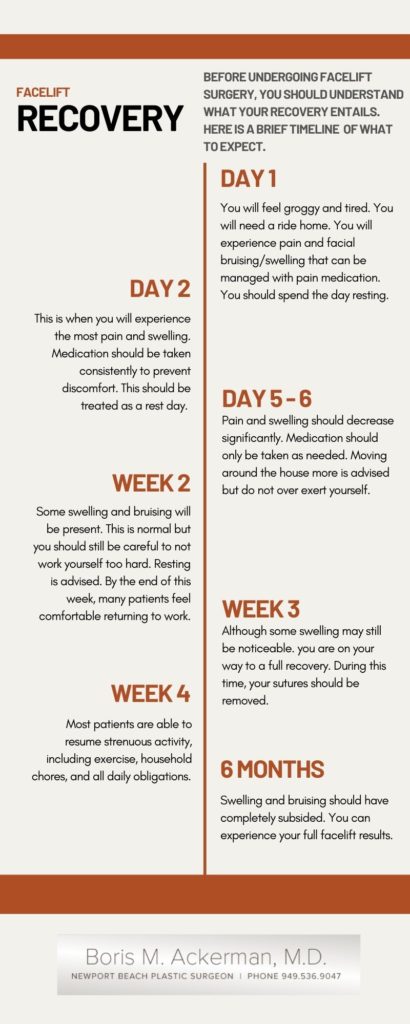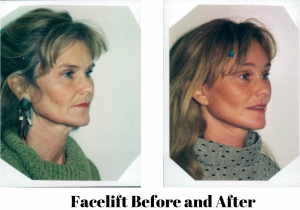What Should I Expect During My Facelift Recovery?
Posted May 05, 2021 in Facelift
6 Minute Read:
For decades, patients have turned to facelift surgery to reduce visible signs of aging and sun damage, such as nasolabial folds, sunken and droopy cheeks, and jowls, in the middle and lower regions of the face. A facelift, or rhytidectomy, also addresses the aging appearance of the neck.

This procedure restores vitality to an aged complexion in a single treatment. While many facelift patients discover that their recovery period is not as involved as they thought, it is important to know what you are getting into before undergoing surgery.
Table of Contents:
What Will It Be Like Returning Home From the Procedure?
What Will the Pain Be Like During My Facelift Recovery?
Where Will My Facelift Incisions Be?
How Should I Care for My Incisions?
What Will It Be Like Returning Home From the Procedure?
Facelift surgery is an outpatient treatment, meaning that there is no need for hospitalization. Most patients recover at home, under the care of a family member or a friend. Some patients choose to recover in a dedicated recovery retreat for a day or two, but that is not required.
Dr. Ackerman operates an on-site, fully certified outpatient surgery center for patients’ safety, privacy, and convenience.
There is very little care required after a facelift. A friend or a family member can easily take care of the patient for the first 24 to 48 hours. All the bandages are removed the day after surgery. After that, most patients can perform everyday activities, such as simple food preparation, walking around the house, and bathroom visits, on their own.
What Are My Limitations?
Facelift surgery requires certain precautions, and you have to accept that there will be some downtime and mild to moderate discomfort for a couple of days.
Patients typically rest in bed the first day after the surgery, but, after that, Dr. Ackerman encourages his patients to be up and around, returning to bed only for brief rest periods.
Having a calm and restful environment at home is important. It is not uncommon to feel somewhat tired for the first 48 hours.
Most of our patients experience only mild swelling and bruising. Dr. Ackerman has designed a “Facelift Recovery Protocol” that includes certain vitamins and homeopathic remedies that tend to speed up the recovery process.

What Will the Pain Be Like During My Facelift Recovery?
Oral prescription medication, cold compresses, or over-the-counter pain medications can help remedy any discomfort. Keeping your head elevated when you are resting will help with blood circulation, thus reducing swelling.
Our office will provide easy-to-follow written instructions.
How Should I Sleep?
Sleeping during your facelift recovery may feel different than what you are used to.
You will need to sleep on your back with your head elevated for at least two to four weeks. An elevated head will help promote healing by preventing bruising and swelling.
If you do not usually sleep on your back, this will take some getting used to. If you sleep with a partner, it is recommended that you ask them to watch out for your head falling in your sleep.
While accidents may happen, you should try your best to keep yourself elevated at all times.
During your recovery, pillows will be your best friend. Consider sleeping with a stack of two or three pillows behind your head and neck to keep you upright throughout the night.
Where Will My Facelift Incisions Be?
Facelift incisions start at the hairline near the temples and curve around toward the back of the ear. It is through these incisions that the excess skin is trimmed, and the underlying tissues are tightened. Dr. Ackerman has perfected the incision placement to avoid any tell-tale signs of a facelift. All of the scalp hair is meticulously preserved.
Typically the incisions heal imperceptibly.
How Should I Care for My Incisions?
The incisions do not require any special care. Dr. Ackerman personally changes the bandages the next day and thoroughly inspects the incisions.
Simple instructions will be given after the bandages are changed. Typically patients are allowed to wash their hair and get the incisions wet after about three days.
Healing incisions must be kept out of the sun.
Most patients do not require any special incision treatments, but on occasion, some creams will be prescribed for optimum care. Do not treat your incisions on your own without specific instructions from your surgeon.
When Can I Return to Work?
While everyone recovers at different rates, most facelift patients are up to returning to work and their regular routines after 10 to 14 days. By this point, most of the bruising and swelling will have subsided, and any remaining marks can be covered with makeup.
Facelift patients should still be cautious about over-exerting themselves or placing any excess strain on the face or incisions.
For the purposes of exercise and most social encounters, you can expect to be completely healed and back to normal after four to six weeks. However, final healing can take a few months.
How Do I Maintain My Results?
The effects of your face surgery will remain visible for many years as long as you maintain a healthy lifestyle. It is important to remember that facelift surgery can only target the visible aging present at the time of the procedure. No treatment will prevent future aging from occurring.
Sun damage is the quickest way to reverse the effects of your facelift. To avoid additional damage to your skin, wear a broad-spectrum sunscreen regularly, avoid being in the sun during
peak hours, and always have sunglasses and a hat that will cover the face and neck.
Can My Facelift Be Redone?
If you notice future aging signs developing on your face that you would like to eliminate, facelift surgery can be redone. However, less-invasive facial rejuvenation treatments can be done to treat minor aging signs, helping to maintain your facelift results even years later.
Facial rejuvenation options include:
BOTOX® Cosmetic
BOTOX® Cosmetic is an injectable that reduces fine lines and wrinkles. This treatment can be done to improve or prevent aging signs.
Skin Care
Skin care treatments, such as chemical peels and exfoliation, can be used to help patients achieve brighter, more youthful skin.
Laser Procedures
Laser treatments can be used on the face to promote collagen production, creating healthy-looking, younger skin.
Injectables
Injectable dermal fillers work to restore facial volume lost during the aging process.
Interested in Learning More?
For more information about what to expect after your facelift, contact Dr. Ackerman by calling (949) 759-3284 or filling out our online contact form.


